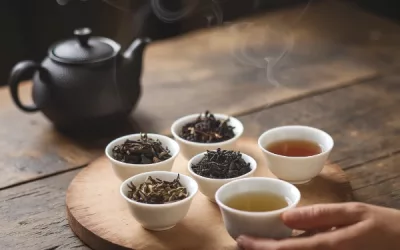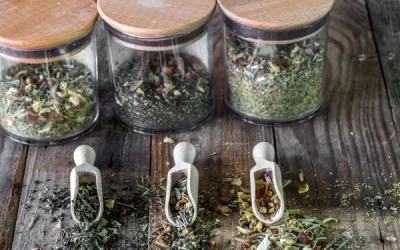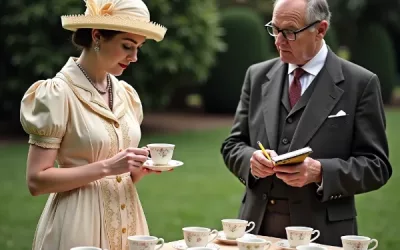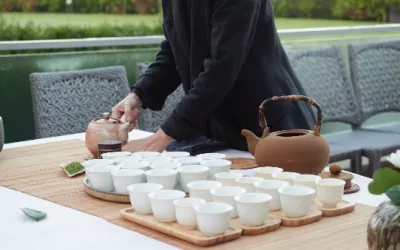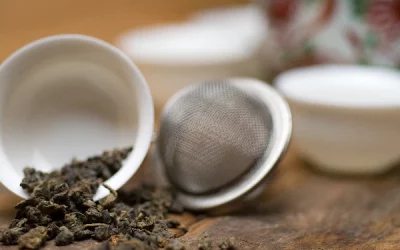Have you ever brewed a cup of tea that just didn’t pack the punch you craved? You’re not alone! Many tea enthusiasts long for a stronger, more flavourful brew but might not know how to achieve it. This guide will demystify the art of brewing stronger tea, exploring key factors like tea type, brewing time, and ratios. Whether you’re looking to enhance your daily cuppa or impress guests, mastering these techniques will elevate your tea experience. Let’s dive into the expert tips that will unlock the full potential of your tea leaves!
Table of Content
- What are the key factors that influence tea strength?
- How can I adjust the tea-to-water ratio for stronger tea?
- What Techniques Can Prevent Bitterness While Making Tea Stronger?
- What are the best practices for brewing loose leaf tea?
- How does steeping time vary across different tea types?
- How can I make stronger iced tea?
- What common mistakes should I avoid when brewing strong tea?
- How can I experiment with different tea blends for stronger flavours?
- Conclusion
What are the key factors that influence tea strength?
If you want to know how to make tea stronger, understanding the key factors that influence its strength is crucial. The strength of tea largely depends on several elements such as the type of tea, water quality, brewing time, tea-to-water ratio, and infusion method. These factors work together to create the perfect cup of tea that is rich in flavour and aroma.
Let’s dive into each factor in detail.
Tea type is perhaps the most significant factor. Different types of tea leaves release flavours at varying levels. For instance, black tea tends to be stronger than green tea due to its longer oxidation period. Water quality is equally important. The minerals present in water can either enhance or diminish the tea’s flavour.
Moreover, brewing time is another key element. Steeping the tea for a longer period allows more compounds to be extracted, making the tea stronger. The tea-to-water ratio also plays a role. More tea leaves relative to water will naturally result in a stronger brew.
Lastly, the infusion method matters; whether you use a teapot, an infuser, or simply a teabag can affect how the tea leaves interact with water.
How does the type of tea affect its strength?
The type of tea you choose significantly affects the strength of your brew. Teas come from the Camellia sinensis plant but vary in processing methods which affects their strength.
- Black Tea: Fully oxidised, resulting in a robust and strong flavour.
- Green Tea: Minimally oxidised, often lighter and more delicate in taste.
- Oolong Tea: Partially oxidised, offering a balance between black and green tea.
- White Tea: Least processed, providing a very mild flavour profile.
- Herbal Tea: Not true tea, made from herbs, flowers, and spices, varying widely in strength.
Black tea releases the most flavour because of its extended oxidation process. Green and white teas, having undergone minimal oxidation, produce a lighter brew. Oolong tea, with its partial oxidation, offers a complex flavour that can be either light or strong depending on brewing techniques.
What role does water quality play in brewing tea?
Water quality directly impacts the flavour and strength of your tea. Using the right type of water can make a noticeable difference.
- Tap Water: Often contains chlorine and minerals that can alter the taste.
- Filtered Water: Removes impurities, ensuring a cleaner flavour.
- Bottled Water: Can be a good option but may contain added minerals.
- Spring Water: Often the best choice, balancing minerals that enhance flavour.
- Distilled Water: Lacks minerals, resulting in a flat-tasting tea.
Filtered or spring water is usually the best choice. Minerals in spring water can enhance the tea’s natural flavours, while filtered water ensures no unwanted chemicals interfere with the taste.
How can brewing time impact the flavour?
The length of time you brew your tea significantly impacts its flavour and strength. Oversteeping or understeeping can result in a less than perfect cup.
- Short Brewing Time: Results in a milder flavour.
- Medium Brewing Time: Typically recommended for balanced strength.
- Long Brewing Time: Extracts more compounds, making the tea stronger but can become bitter.
- Re-steeping: Some teas like oolong and green can be re-steeped for additional infusions.
Steeping time is crucial. If you want a stronger tea, let it brew longer, but be cautious not to oversteep as it can turn bitter. It’s always best to follow the recommended brewing time for each type of tea.
In the 19th century, tea played a significant role in British culture. The story of Anna, the Duchess of Bedford, highlights this. She is credited with popularising “afternoon tea” in the 1840s. To combat the “sinking feeling” during the late afternoon, she requested a small meal with tea and snacks.
This practice became so popular that it evolved into a social event, deeply ingrained in British culture. Anna’s preference for stronger black tea with milk and sugar set a trend that continues today.
I remember the first time I attempted to brew a strong cup of tea. I used tap water, steeped the tea for too long, and ended up with a bitter mess. After some trial and error, I switched to spring water, tweaked the brewing time, and found the right tea-to-water ratio.
The result? A robust and flavourful cup that I now enjoy daily. Keep experimenting until you find what works best for you!
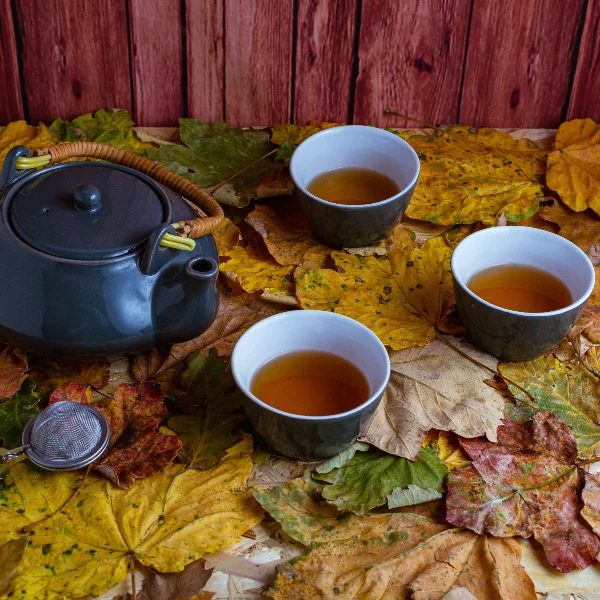
How can I adjust the tea-to-water ratio for stronger tea?
Adjusting the tea-to-water ratio is one of the most straightforward methods to create a stronger cup of tea. Essentially, you want to increase the amount of tea leaves or tea bags you use while maintaining or slightly reducing the amount of water.
It’s a simple yet effective way to enhance the flavour and strength of your brew. Below is a detailed table that breaks down recommended tea amounts for different strengths and types of tea.
By increasing the quantity of tea leaves or bags and keeping an eye on steeping time, you can control the intensity of the flavour. Whether you prefer black, green, or herbal tea, this table will serve as your guide.
Recommended tea amounts for different strengths and types of tea
| Tea Type | Recommended Amount Per Cup | Strength Level |
|---|---|---|
| Black Tea | 1 tsp | Mild |
| Black Tea | 1.5 tsp | Medium |
| Black Tea | 2 tsp | Strong |
| Green Tea | 1 tsp | Mild |
| Green Tea | 1.5 tsp | Medium |
| Green Tea | 2 tsp | Strong |
| Oolong Tea | 1 tsp | Mild |
| Oolong Tea | 1.5 tsp | Medium |
| Oolong Tea | 2 tsp | Strong |
| Herbal Tea | 1 tsp | Mild |
| Herbal Tea | 1.5 tsp | Medium |
| Herbal Tea | 2 tsp | Strong |
| White Tea | 1.5 tsp | Mild |
| White Tea | 2 tsp | Medium |
| White Tea | 2.5 tsp | Strong |
To use the table, simply look for the type of tea you’re brewing. The table lists the recommended amounts per cup for varying strength levels. For example, if you’re brewing black tea and you want it strong, use 2 teaspoons per cup.
Adjust the amount of water accordingly and steep as usual. This method ensures you get a cup that aligns with your preferred strength without overpowering the delicate flavours.
How do steeping times affect the strength of tea?
Steeping time is another critical factor in achieving a stronger tea. The longer you steep your tea, the more compounds are released, increasing both the strength and bitterness.
However, it’s essential not to oversteep, as it can lead to an unpleasant taste.
Understanding the right balance is key.
- Black Tea: Steep for 3-5 minutes
- Green Tea: Steep for 2-3 minutes
- Oolong Tea: Steep for 4-7 minutes
- Herbal Tea: Steep for 5-7 minutes
- White Tea: Steep for 4-5 minutes
If you steep your tea longer than these recommended times, you can risk extracting too many tannins, leading to a bitter flavour. It’s about finding the sweet spot for your taste preferences.
What role does water temperature play in tea strength?
Water temperature plays a huge role in how strong your tea will be. Different types of tea require different temperatures to bring out their best qualities. Using water that’s too hot or too cold can interfere with the flavour.
- Black Tea: Boiling water (100°C)
- Green Tea: Water at 75-85°C
- Oolong Tea: Water at 85-90°C
- Herbal Tea: Boiling water (100°C)
- White Tea: Water at 75-85°C
Ensure you’re using the right temperature for your tea type. For example, using boiling water for green tea can scald the leaves, resulting in a bitter taste.
In the early 17th century, tea became popular in England, thanks to Catherine of Braganza, the Portuguese queen of King Charles II. She introduced tea drinking to the English court, and it quickly became a fashionable beverage.
As tea gained popularity, brewing techniques evolved, leading to the refined methods we use today.
I remember my grandmother teaching me the art of brewing the perfect cup of strong tea. She always insisted on using loose leaves and a timer to get the steeping just right. Her kitchen smelled of freshly brewed tea, and those moments became a cherished part of my routine.
Each cup felt like a warm hug, a blend of tradition and comfort.
What Techniques Can Prevent Bitterness While Making Tea Stronger?
When it comes to brewing the perfect cup of tea, there’s a fine line between strong and bitter. Unfortunately, many well-intentioned tea enthusiasts end up crossing that line. The secret to making tea stronger without causing bitterness involves a combination of selecting quality ingredients, adjusting steeping time, and getting the temperature just right. So, let’s dive into the specifics.
You might think strong tea requires endless steeping with an army of tea bags. Wrong. Bitterness is often a result of over-steeping and using water that’s too hot. Think of it like baking: you wouldn’t keep a cake in the oven too long or at too high a temperature, because it would burn, right? Well, the same logic applies to tea.
Let’s break down some techniques to help you avoid that bitter aftertaste while enhancing the strength and flavour of your brew.
What Is The Optimal Steeping Time For Different Tea Types?
Steeping time varies dramatically depending on the type of tea. Each tea variety has its own Goldilocks zone – not too long, not too short, but just right.
- Green Tea: Steep for 1-3 minutes. Any longer and you’ll be chugging liquid grass.
- Black Tea: Steep for 3-5 minutes. Perfect for a robust flavour without the bitter notes.
- Oolong Tea: Steep for 3-5 minutes. Rich flavour with subtler nuances.
- White Tea: Steep for 4-5 minutes. Delicate but full-flavoured when done right.
- Herbal Tea: Steep for 5-7 minutes. These need a bit longer due to their often hearty ingredients.
Steeping times are like Tinder swipes: too much or too little, and it’s not going to end well. Proper steeping time allows the flavours to bloom without releasing excessive tannins, which contribute to bitterness.
How Does Water Temperature Affect Tea Flavour?
Water temperature is the unsung hero (or villain) in tea brewing. Get it wrong, and you’re guzzling bitterness; get it right, and you’re sipping perfection.
- Green Tea: 70-80°C (158-176°F). Anymore, and you’ll char those delicate leaves.
- Black Tea: 90-100°C (194-212°F). These stand up to heat like champs.
- Oolong Tea: 85-90°C (185-194°F). Balanced to bring out complex flavours.
- White Tea: 70-85°C (158-185°F). Treat these leaves gently.
- Herbal Tea: 100°C (212°F). No such thing as too hot for these hearty brews.
Water that’s too hot will scorch the leaves, leading to bitterness and an overall unpleasant experience. Stick to the sweet spot for each type of tea, and you’ll be well on your way to a flavourful, strong brew.
Can Using More Tea Bags Help Without Bitterness?
Think you can whip out an extra tea bag like a magic wand to make your tea stronger? Think again. More isn’t always merrier.
- More Bags: Use sparingly. Unless you want a bitter brew, avoid dumping in an extra bag.
- Loose Leaf Tea: Better control over the strength and flavour.
- Serving Size: 1 teaspoon per cup, generally. Avoid overloading to prevent bitterness.
- Balance Flavour: Use more leaves/bags only if needed and adjust steeping time.
- Quality Over Quantity: Fresh, high-quality tea offers stronger flavours without the need for extras.
So, instead of doubling down on tea bags, invest in quality leaves or a loose-leaf tea infuser. You’ll get a more nuanced, stronger cup without venturing into Bitterville.
In 1840, tea aficionados faced an epic innovation. Anna, the Duchess of Bedford, couldn’t stand the tiresome hours between lunch and dinner. Her solution? Afternoon Tea. She didn’t just throw bags in hot water; she perfected it.
Tea, accompanied by sweet treats and light sandwiches, became a celebrated ritual—a smooth, balanced brew to stave off bitterness and hunger.
Getting your tea right isn’t rocket science—it’s more like alchemy. Follow these techniques, adjust your steeping times, respect temperature guidelines, and recognise when less is more with tea bags. You’ll be elevating your tea game to duchess levels in no time.
What are the best practices for brewing loose leaf tea?
If you’re looking to step up your tea game, brewing loose leaf tea is a surefire way to get there—assuming you don’t botch it. Stay sharp and follow these best practices, and your tea will be legendary.
Loose leaf tea can elevate your daily brew into an extraordinary experience. Let’s dive into the effective techniques that can make or break your tea game.
How should I measure loose leaf tea for strength?
You don’t want a weak tea that tastes like a forgotten bathwater, do you? The strength of your tea can make a world of difference, and it all starts with measuring your loose leaf tea accurately.
- General Rule of Thumb: Use about 1 teaspoon of tea leaves per 8 ounces of water. But hey, rules are meant to be broken.
- Golden Ratio: For a stronger cup, push it up to 1.5 or even 2 teaspoons per 8 ounces. You be the boss!
- Timing: Remember, steeping time also plays a critical role. More leaves can mean less steeping time.
- Quality Matters: Higher quality leaves often expand more, so a smaller quantity might still pack a punch.
- Personal Preference: Always adjust based on your own taste buds. They know best.
It’s essential to measure accurately because too little leaves you with a disappointing cup, while too much turns it into a bitter disaster.
What types of infusers work best for loose leaf tea?
Say goodbye to those flimsy teabags and hello to infusers that actually get the job done. The type of infuser you use is crucial for getting the most out of your leaves.
- Tea Balls: Spherical but often too small. They don’t give the leaves much room to expand.
- Mesh Infusers: Better than tea balls but still limited in space.
- Tea Baskets: Now we’re talking. These give your leaves enough room to dance freely.
- Reusable Cloth Bags: Eco-friendly and quite decent in ensuring a proper brewing.
- In-Mug Infusers: Fits right into your mug, offering both convenience and effectiveness.
A good infuser will let your tea leaves stretch their legs and mingle with the water, ensuring an even extraction of flavour. Don’t cramp their style.
How can I ensure even brewing with loose leaves?
Having inconsistent tea is the equivalent of watching a film with missing scenes. To avoid this drama, ensure those leaves get a balanced soak.
- Stir It Up: Give your tea a gentle stir halfway through the brewing.
- Temperature Control: Use water at the proper temperature. Too hot, and you’ll scorch the leaves; too cold, and they’ll sulk.
- Water Quality: Pure, filtered water free from impurities does wonders.
- Pre-rinse Leaves: A quick rinse with hot water can wake the leaves up and prepare them for brewing.
- Tea Pots with Built-in Infuser: These create a happy environment for even exposure.
Nailing down even brewing ensures consistency in every sip. You’ll get the full spectrum of flavours, not just a disappointing hint.
Alright, tea enthusiasts, let’s step back in time. In ancient China, tea masters would spend years mastering the art of tea brewing. Legend has it that Lu Yu, the Sage of Tea, had a meticulous process for every tiny detail, from water type to tea utensils.
His “Classic of Tea” became the bible for tea lovers everywhere. It’s said that he could detect the slightest deviation in brewing and would rather drink plain water than a poorly made cup of tea. So, when you’re brewing your next cup, channel a bit of that dedication.
If Lu Yu managed to perfect his tea game centuries ago, you can handle a teaspoon measurement.
How does steeping time vary across different tea types?
Tea brewing ain’t rocket science, but it does have its nuances. The steeping time – essentially how long you let those precious leaves sit in hot water – can make or break your cuppa. When it comes to getting the flavour and strength just right, it’s all about knowing the right moments for each type of tea. Let’s break it down.
Different teas need different times in the hot tub, so to speak. Each variety has its own personality and, just like people, needs different treatment. Here’s a rundown of the popular tea types and their perfect steeping scenarios.
What is the ideal steeping time for black tea?
Black tea is the strong, independent type that doesn’t like to be rushed. For a robust cup, aim for:
- Steeping Time: 3-5 minutes.
- Water Temperature: 95-100°C.
- Leaf Amount: Usually around 1 teaspoon per cup.
Spending less than three minutes will leave you with weak sauce instead of strong tea. Go beyond five minutes, and you’re in danger of bitterness – and nobody likes a bitter brew. Remember, patience is key here.
How does steeping time differ for green tea?
Green tea is the delicate, high-maintenance cousin of black tea. Treat it right, and you’ll get a smooth, nuanced flavour. Here’s the scoop:
- Steeping Time: 1-3 minutes.
- Water Temperature: 70-80°C.
- Leaf Amount: About 1 teaspoon per cup.
Since green tea leaves are so delicate, they don’t need much time in the hot water. Oversteeping will make your tea taste like a wet grass smoothie – not a flavour anyone is chasing. Keep it brief and you’ll enjoy a light, refreshing taste.
What steeping time is recommended for herbal teas?
Herbal teas (or tisanes, if you want to sound fancy) are the free spirits of the tea world. They require a bit more TLC compared to their caffeinated cousins:
- Steeping Time: 5-10 minutes.
- Water Temperature: 95-100°C.
- Leaf Amount: Hefty pinch or 1-2 teaspoons per cup.
These aren’t actually ‘teas’ in the traditional sense, but rather infusions of leaves, fruits, roots, and the like. Longer steeping times extract more goodness and flavour. You can be a little more laid-back here – if they steep too long, it usually doesn’t turn into a horror show, just a stronger bouquet.
If you’re feeling a bit adventurous, you might want to explore oolong tea as well. Oolong is the versatile sibling, thriving with a little extra attention:
- Steeping Time: 3-5 minutes.
- Water Temperature: 85-90°C.
- Leaf Amount: 1 teaspoon per cup.
Oolong tea is semi-oxidised, falling between the bold black teas and subtle green ones. Finding the sweet spot in steeping can bring out a unique blend of flavours, making it an interesting choice for the discerning tea drinker.
During the 18th century, Catherine of Braganza, the Portuguese princess who married Charles II of England, became quite the tea trendsetter. She popularised tea drinking among the English aristocracy.
Back then, tea was still a bit of an enigma to many. No one had given much thought to optimal steeping times. It was pretty much a wild west of tea brewing. Some cups came out as pale as a January morning; others were strong enough to reanimate a sloth. If only they had this guide back then!
Next time you brew yourself a delightful cup, remember these steeping times. Your taste buds – and possibly your friends – will thank you. Cheers!
How can I make stronger iced tea?
Do you find iced tea a bit too weak for your taste buds? Well, you’re not alone. In fact, making iced tea strong enough to knock your socks off is an art form. Let’s dive into the details on how you can whip up some seriously strong iced tea, talking about using double the amount of tea, ideal brewing temperatures, and sweetening methods.
First off, let’s talk tea quantity. Using twice the amount of tea than you would for a hot cup is the secret weapon. It sounds simple, but trust me, it’s a game-changer. Measure out a heapin’ helping of those tea leaves or bags and prepare to break free from blandness.
Brewing temperature is another big deal. If you brew at a too-cool temp, you’re basically inviting weak tea to your party. Stick to hot water for a bold infusion, then let it cool down. This method extracts every last bit of flavour from those leaves and delivers the punch you’re yearning for.
Sweeteners? Oh, you’re in for a treat. Syrups, honey, or good old-fashioned sugar can transform your tea. Pour the sweet stuff in while the tea’s still hot to get a smooth, perfectly balanced sip in every gulp.
Now that we have the basics down, let’s answer some sub-questions to help you master the craft of creating powerful iced tea.
How much tea should I use for iced tea?
Here’s the golden rule: double the tea, double the fun. Using twice the usual amount is the optimal way to get that strong, robust flavour without resorting to any sorcery.
- Regular tea: Use 4 tea bags or 4 teaspoons of loose leaf tea per litre of water.
- Herbal tea: Also aim for 4 tea bags or 4 teaspoons per litre, as these are naturally less potent.
- Steeping time: Leave it to steep for around 5–10 minutes to extract maximum flavour.
- Quality matters: Opt for higher-quality leaves if you want top-notch results.
By using double the quantity, you’re ensuring a rich and satisfying drink. You won’t be making any “is that even tea?” comments when you hand it to friends and family.
What is the best way to sweeten iced tea?
Ah, the sweet stuff. It’s crucial for transforming good iced tea into exceptional iced tea. But what’s the best way to sweeten this powerhouse beverage?
- Simple syrup: Dissolve equal parts sugar and water over heat. Sweeten while tea is hot.
- Honey: For a natural twist, drizzle in some honey while the tea is warm.
- Stevia: For a calorie-free alternative, a few drops of Stevia will do the trick.
- Agave nectar: Adds a hint of floral sweetness and works well with herbal teas.
- Flavoured syrups: Vanilla, caramel, or fruit-flavoured syrups can jazz up your tea.
Sweetening your iced tea while it’s still hot is key because it blends better and doesn’t leave you with granules at the bottom of your glass. Go wild and figure out what tickles your taste buds.
Can I brew iced tea with hot water?
Yes, indeed! In fact, brewing iced tea with hot water is the most effective way to get it strong and flavour-packed. Cold brewing might sound fancy, but it doesn’t draw out the flavours like hot water does.
- Boil water and let it slightly cool to around 90°C.
- Pour hot water over the tea bags or loose leaves.
- Let it steep for 5–10 minutes.
- Remove the tea and let it cool to room temperature, then refrigerate.
- Serve over ice for that chilled experience.
By starting with hot water, you’re ensuring that every tea leaf gives up its goodness. So, don’t shy away from the kettle. Embrace the heat, and your taste buds will thank you.
Speaking of strong tea, did you know Winston Churchill was an absolute tea fiend? During World War II, while leading the British to victory with his resolute spirit, he was known to consume gallons of tea.
Churchill’s tea was famously strong, probably just a step away from chewing the leaves. So, if it’s good enough for the man who led Britain through its darkest hours, a strong cup of iced tea might just give you the burst you need to get through your day. Cheers to that!
What common mistakes should I avoid when brewing strong tea?
So, you want to brew a cup of strong tea that could wake a hibernating bear, eh? Well, it’s not as simple as dunking a bag in hot water and hoping for the best. There are a few common mistakes that can turn what should be a good cup of tea into a drink you’d only offer your worst enemy.
Let’s get into the nitty-gritty.
First off, over-steeping your tea is a rookie mistake. Yes, you heard that right; more time in the water doesn’t equal more flavour, it means more bitterness. Long story short: don’t overdo it. Then there’s the issue of poor-quality tea.
If you’re using floor sweepings masquerading as tea leaves, no amount of technique will save you. Lastly, not all hot water is created equal. Using boiling water is great if you’re looking to strip wallpaper, but not so much for brewing delicate tea leaves.
What are the signs of over-steeping tea?
Over-steeping isn’t just a fancy word we tea geeks like to throw around. It’s a serious crime in the world of tea brewing. Signs you’ve oversteeped are glaringly obvious.
- A strong, bitter taste that feels like it’s assaulting your taste buds.
- An astringent, dry mouthfeel afterwards.
- A mouthful of tannins that make you wonder if you accidentally brewed a cup of wet cardboard.
- A darker-than-usual tea colour that makes you question your life choices.
- A noticeable decline in the tea’s subtle flavours and aromas.
Overstepping can strip away the delicate balance of flavours that make tea, well, tea. You’re left with an overly intense, bitter drink rather than a robust, flavourful one.
How can I identify quality tea leaves?
You can’t make a silk purse out of a sow’s ear, right? Same logic applies to tea. Identifying quality tea leaves can make or break your tea-drinking experience.
- Look for whole, unbroken leaves. Avoid dust or fannings.
- Smell your tea. Quality leaves will have a rich, fresh aroma.
- Look at the colour; good tea leaves are often vibrant and uniform.
- Check for consistency. All leaves should look similar; avoid anything with too many stems or discoloured bits.
- Expensive doesn’t always mean quality, but bargain-basement prices usually mean you’re buying something fit for compost.
By knowing what to look for, you can avoid the mistake of using subpar leaves. When you start with quality ingredients, you’re more likely to get a better brew.
What is the impact of using boiling water?
Using boiling water may seem like a good idea until you realise it’s the equivalent of a poor man’s jackhammer on your delicate tea leaves. Here’s why you shouldn’t do it:
- Boiling water can burn the leaves, especially green and white teas, leading to a really bitter taste.
- It can destroy the nuanced flavours and aromas, leaving you with a flat, one-dimensional drink.
- It’s particularly bad for more delicate teas, obliterating their subtle sweetness.
- Overly hot water can accelerate the extraction of tannins, making the tea harsh and astringent.
- It can cause the leaves to release unpleasant compounds that you neither need nor want in your cup.
Basically, using boiling water is like cooking a gourmet meal at maximum heat. There is such a thing as too much of a good thing, and in the world of tea, boiling water is that “too much.”
Back in the day, in the Qing Dynasty of China, tea connoisseurs would use a special technique for boiling water called “fish eyes.” This method involved heating the water until the bubbles were as large as fish eyes, then removing it from heat to cool slightly before brewing.
It shows that even centuries ago, folks knew the importance of not using boiling water for their precious leaves. If it was good enough for them, it’s good enough for us modern tea nerds.
How can I experiment with different tea blends for stronger flavours?
So, you want to master the art of tea blending, channel the spirit of a mad scientist, and create a powerful tea concoction that will leave your taste buds doing somersaults? Well, you’re in luck, my tea-loving friend.
Bust out those teacups and get ready to play with flavours! Experimenting with tea blends isn’t just for fancy tea shops. You can do it at home without needing a PhD in chemistry. It’s all about understanding a few basic principles. Let’s dive in.
To start, blending different types of tea can be like mixing paints to create a unique masterpiece. The key lies in balance and variety. The right combination can make or break your tea experience. Don’t be afraid to try unconventional pairings. Channel your inner mixologist and see what works best for your palate. Plus, it’s a great excuse to throw a tea party!
What tea types blend well together?
Ah, the magic question. Not all teas are created equal, and some play better together than others.
- Black Tea + Green Tea: A yin-yang combo that brings robustness with a hint of freshness.
- White Tea + Herbal Tea: Flowery notes meet delicate flavours.
- Oolong + Jasmine: Earthy layers are complemented by floral fragrances.
- Rooibos + Spiced Chai: Sweetness and spice and everything nice!
If you’re feeling adventurous, don’t shy away from adding dried fruits, spices, or even flower petals. A dash of cinnamon or a sprinkle of lavender can elevate your blend to new heights.
To sum it up, knowing the general characteristics of each tea type can make your blending experience go from “meh” to “WOW!”
How can I develop my own tea blend?
Okay, so you’re ready to concoct your special brew. Developing your proprietary tea blend isn’t as tricky as solving a Rubik’s Cube, though it can be just as fun.
- Start Simple: Begin with two types of tea. Mixing more than that can get complicated.
- Taste Test: Steep small batches and taste as you go. Adjust accordingly.
- Keep Notes: Jot down what works and what doesn’t. You don’t want to forget that genius blend.
- Experiment with Non-Teas: Think mint leaves, orange peel, or even a star anise.
Developing your blend is like cooking a dish: it’ll take patience, trial, and error. But once you find the perfect mix, it’ll be worth every misstep.
Don’t forget about brewing time and water temperature. These factors can make a big difference. You might find that steeping your blend a little longer or at a different temperature brings out unexpected nuances.
What factors should I consider when blending teas?
Now, let’s get to the nitty-gritty. Every blend you attempt should consider the following:
- Flavour Profile: Determine what you’re aiming for. Do you want something fruity, floral, or spicy?
- Strength: How strong is each component? A robust black tea will overshadow a delicate white tea.
- Aroma: The scent adds to the experience. Make sure it’s pleasant.
- Colour: A visually appealing tea can make it more enjoyable to drink.
- Health Benefits: Think about what you want out of your blend—relaxation, energy boost, or digestive help.
And remember, everyone’s palette is different. What might taste heavenly to you could be another person’s cup of yuck.
Blending teas is a journey, not a destination. Keep experimenting, tasting, and scribbling down notes until you find the perfect brew. Think of it like alchemy—except way tastier.
In 1840s England, Anna, the Duchess of Bedford, found herself famished in the late afternoon. Dinner was served late, around 8 p.m., leaving a long, hungry gap in the day. She started taking tea with bread and butter to curb her afternoon hunger pangs, eventually inviting friends to join her.
This simple act gave birth to the elegant ritual of afternoon tea, with tea blending becoming a part of the tradition. If Anna could revolutionise tea drinking with a simple idea, imagine what you can do with a blend of your own making.
Go forth and blend, my tea aficionados!
Conclusion
Reflecting on the journey of enhancing tea strength reveals a tapestry of factors contributing to a perfect brew. We delved into the vital aspects of tea type, water quality, and brewing time—each playing a significant role in achieving the robust flavours we seek.
By understanding how different teas react to the elements of preparation, we empower ourselves to create a cup that truly reflects our palate.
Adjusting the tea-to-water ratio emerged as a straightforward yet impactful technique we can readily incorporate into our brewing routine. The table I provided serves as a useful guide, offering clarity on how to tailor our tea amounts according to our desired strength.
This personalised approach not only elevates our tea experience but encourages us to experiment and refine our craft.
Moreover, discovering ways to enhance tea strength without falling victim to bitterness is crucial for any tea enthusiast. We explored optimal steeping times and the right water temperatures that flatter each tea type, ensuring we strike that delicate balance in flavour.
Remember, the adventure doesn’t end with knowing these techniques; it inspires further exploration into the world of loose leaf brewing and blending unique flavour profiles.
As I consider the importance of these insights, it’s clear that our relationship with tea can be as intricate and rewarding as we choose to make it. I encourage you to embrace the art of experimentation, blending, and observation. After all, what is brewing tea if not a reflection of our tastes, preferences, and, indeed, our identities?
Let us keep questioning: What new blend or technique will you try today to create a stronger, more flavourful tea? In the end, each cup we brew is a step towards becoming true aficionados, capable of crafting not just stronger tea, but moments of connection and joy.
Resources
- The Effect of Brewing Time on the Antioxidant Activity of Tea Infusions
- How brewing parameters affect the healthy profile of tea
- Steeping temperature and time may affect antioxidants in tea
- Effects of brewing water on the volatile composition of tea infusions
- Bitterness and astringency of tea leaves and products: Formation …
- The Effect of Brewing Time on the Antioxidant Activity of Tea …
- Quality analysis and antioxidant activity of different types of tea …
- Impact of tea leaves types on antioxidant properties and bioaccessibility of kombucha
- Comparison of antioxidant capacities of different types of tea using …


